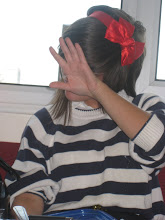From reading the books I got out a couple of weeks ago, I've learnt a lot about the history of wallpaper, pattern and also artists I like.
The earliest history of wallpapers in England, were individual sheets, decorated with geometrical woodcut patterns and printed in black ink on pale paper by a hand-operated press in the same way as the leaves of a book; sometimes they were hand coloured.
Fragments of some of these earlt sheets have survived: they can be dated back as far as the late sixteenth century to the mercantile boom and busy urban growth that characterised the reign of Queen Elizabeth.
As printing and publishing grew, so did wallpaper: the sale of wallpaper was then associated with the stationery business. Papers might be used for lining boxes as well as for decorating the walls of a room.
Towards the end of the Seventeenth century London had become a centre for wallpapers, sold at a wide range of prices to reflect the trouble taken in their manufacture and the extent to which they reflected popular fashion.
In most recent years, designers have entered a new phase of creativity, experimenting with many different styles, applications and materials. This is what I am trying to explore throughout this brief.
In order to find out why wallpaper has come back, we have to look at wider cultures of consumption and how they have affected it's revival. An availability of new styles did not cause an upturn of interest in wallpaper in the mid-1990's it was still languishing in a back cupboard. The consequent interest in 'Do It Yourself' home decoration sped up the cycle of decoration of homes. At one time wall might have been papered and left for decades, but alongside these social developments constant redecoration became the norm. The decoration frenzy was fuelled by a rise in the number of television programmes and magazines about interior design.
Some artists I have found in books are Louise Body, who looks alot at birds and birdcages. She uses a process of handprinting and hand-finishing, rooted in wallpaper tradition Body has updated the classic floral pattern...
 Also Johanna Basford, her work is inspired by the wildlife and nature that surrounds her. She does delicate hand drawings of imagined botanicals, butterflies and beatles, re-inventing traditional victorian motifs...
Also Johanna Basford, her work is inspired by the wildlife and nature that surrounds her. She does delicate hand drawings of imagined botanicals, butterflies and beatles, re-inventing traditional victorian motifs...

No comments:
Post a Comment